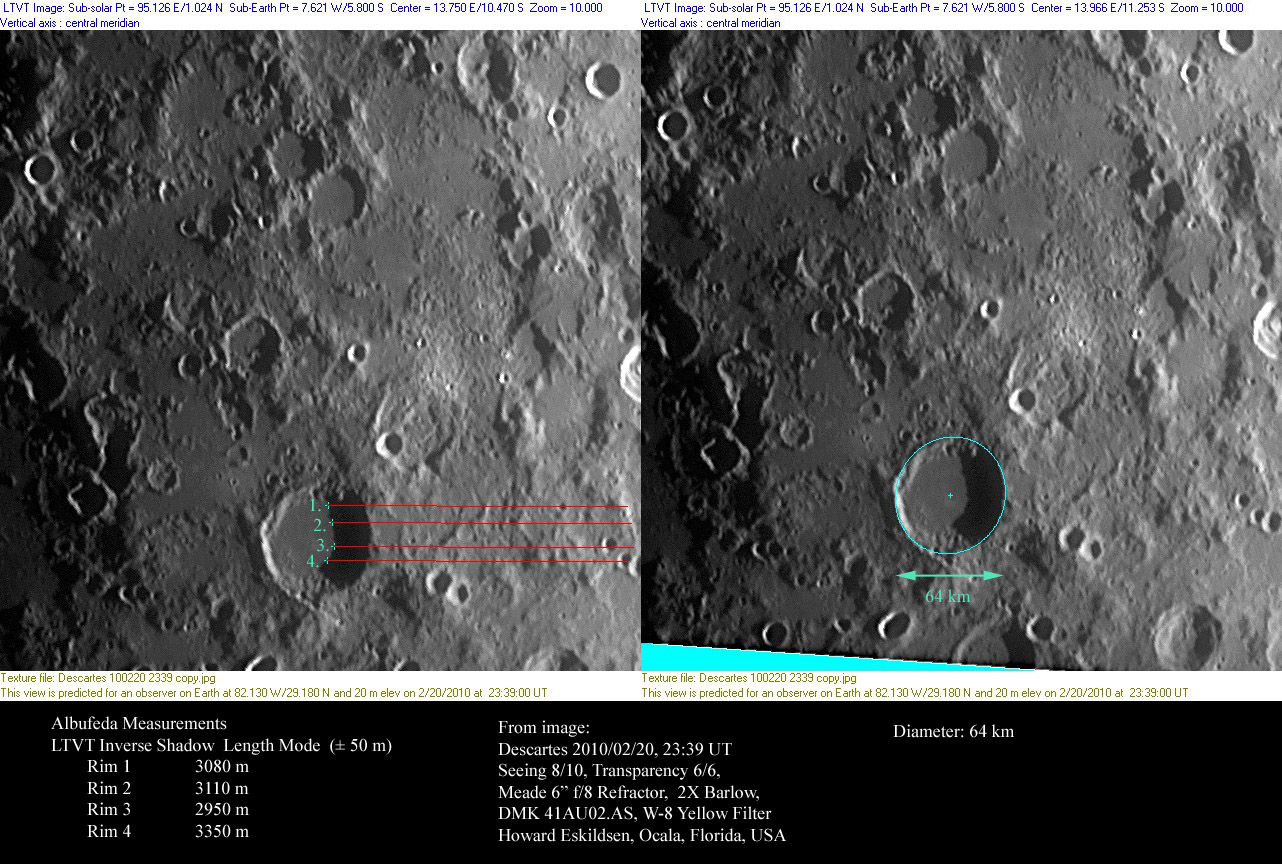Difference between revisions of "June 26, 2010"
| Line 3: | Line 3: | ||
<!-- ws:start:WikiTextHeadingRule:1:<h1> --> | <!-- ws:start:WikiTextHeadingRule:1:<h1> --> | ||
<!-- ws:start:WikiTextLocalImageRule:16:<img src="/file/view/LPOD-June26-10.jpg/150585639/LPOD-June26-10.jpg" alt="" title="" /> -->[[File:LPOD-June26-10.jpg|LPOD-June26-10.jpg]]<!-- ws:end:WikiTextLocalImageRule:16 --><br /> | <!-- ws:start:WikiTextLocalImageRule:16:<img src="/file/view/LPOD-June26-10.jpg/150585639/LPOD-June26-10.jpg" alt="" title="" /> -->[[File:LPOD-June26-10.jpg|LPOD-June26-10.jpg]]<!-- ws:end:WikiTextLocalImageRule:16 --><br /> | ||
| − | <em>image and analysis by [mailto:howardeskildsen@msn.com | + | <em>image and analysis by [mailto:howardeskildsen@msn.com Howard Eskildsen]</em><br /> |
<br /> | <br /> | ||
| − | [/June+9%2C+2010 Earlier] in the month Howard showed how easy it is to measure crater depths using LTVT. He can't stop doing it, partially because of the thrill of deriving accurate and useful information from his own images. When I looked at this latest effort I realized that although LRO altimetry data may very well be used to measure crater depths - because there are catalogs of craters that can be used to guide automated software routines to make the measurements - there are other types of lunar landforms that will be harder to measure robotically. I am thinking specifically of peaks. There must be hundreds - perhaps thousands? - of peaks that were lettered by Mädler, Neison and Schmidt for which no modern data are available. Most of these peaks were re-examined in the early 1960s for the maps accompanying the <em>[http://the-moon.wikispaces.com/System+of+Lunar+Craters System of Lunar Craters]</em>, but they were not catalogued. It would be possible for a small group of people to follow Howard's example and the determine the locations and heights of all major lunar elevations. That would be a basic contribution to lunar knowledge. I would recommend using the highest resolution images available and systematically measure all the Greek-lettered peaks on the <em>System</em> [http://www.lpod.org/?m=20071205 | + | [/June+9%2C+2010 Earlier] in the month Howard showed how easy it is to measure crater depths using LTVT. He can't stop doing it, partially because of the thrill of deriving accurate and useful information from his own images. When I looked at this latest effort I realized that although LRO altimetry data may very well be used to measure crater depths - because there are catalogs of craters that can be used to guide automated software routines to make the measurements - there are other types of lunar landforms that will be harder to measure robotically. I am thinking specifically of peaks. There must be hundreds - perhaps thousands? - of peaks that were lettered by Mädler, Neison and Schmidt for which no modern data are available. Most of these peaks were re-examined in the early 1960s for the maps accompanying the <em>[http://the-moon.wikispaces.com/System+of+Lunar+Craters System of Lunar Craters]</em>, but they were not catalogued. It would be possible for a small group of people to follow Howard's example and the determine the locations and heights of all major lunar elevations. That would be a basic contribution to lunar knowledge. I would recommend using the highest resolution images available and systematically measure all the Greek-lettered peaks on the <em>System</em> [http://www.lpod.org/?m=20071205 maps] or the summary <em>[http://lpod.wikispaces.com/August+24%2C+2009 Lunar Designations and Positions]</em> quadrant charts.<br /> |
<br /> | <br /> | ||
| − | <em>[mailto:tychocrater@yahoo.com | + | <em>[mailto:tychocrater@yahoo.com Chuck Wood]</em><br /> |
<br /> | <br /> | ||
<strong>Technical Details</strong><br /> | <strong>Technical Details</strong><br /> | ||
| Line 16: | Line 16: | ||
<br /> | <br /> | ||
<hr /> | <hr /> | ||
| − | <div>You can support LPOD when you buy any book from Amazon thru [http://www.lpod.org/?page_id=591 | + | <div>You can support LPOD when you buy any book from Amazon thru [http://www.lpod.org/?page_id=591 LPOD!]<br /> |
</div> | </div> | ||
---- | ---- | ||
===COMMENTS?=== | ===COMMENTS?=== | ||
| − | + | Register, and click on the <b>Discussion</b> tab at the top of the page. | |
Revision as of 17:21, 11 January 2015
A Call To Arms

image and analysis by Howard Eskildsen
[/June+9%2C+2010 Earlier] in the month Howard showed how easy it is to measure crater depths using LTVT. He can't stop doing it, partially because of the thrill of deriving accurate and useful information from his own images. When I looked at this latest effort I realized that although LRO altimetry data may very well be used to measure crater depths - because there are catalogs of craters that can be used to guide automated software routines to make the measurements - there are other types of lunar landforms that will be harder to measure robotically. I am thinking specifically of peaks. There must be hundreds - perhaps thousands? - of peaks that were lettered by Mädler, Neison and Schmidt for which no modern data are available. Most of these peaks were re-examined in the early 1960s for the maps accompanying the System of Lunar Craters, but they were not catalogued. It would be possible for a small group of people to follow Howard's example and the determine the locations and heights of all major lunar elevations. That would be a basic contribution to lunar knowledge. I would recommend using the highest resolution images available and systematically measure all the Greek-lettered peaks on the System maps or the summary Lunar Designations and Positions quadrant charts.
Chuck Wood
Technical Details
Howard's measurements are consistent with the older value of about 3.2 km, but not with the 1.2 km depth measured by Arthur and colleagues (probably me!) in the early 1970s. It will be useful for someone to use higher resolution images to determine the correct depth.
Related Links
Rükl plate 45
COMMENTS?
Register, and click on the Discussion tab at the top of the page.



